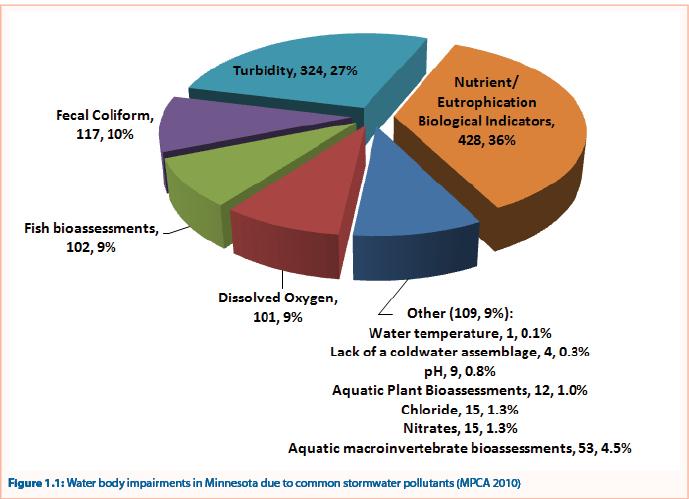
Background
A.J. Erickson, J.S. Gulliver, P.T. Weiss, R.M. Hozalski
The Minnesota Pollution Control Agency (MPCA) is required by the Clean Water Act Section 303 (d), Total Maximum Daily Load (TMDL), to assess water quality and to identify impaired streams and lakes. In the most recent of these assessments (MPCA 2010), there were 1,774 impaired water bodies identified on the 303(d) TMDL list in Minnesota, including 647 lakes and 388 rivers. Recent approval of a statewide Mercury TMDL and Southeast Regional Fecal Coliform TMDL for Minnesota has resulted in a significant decrease in listed impairments from previous years. The 2008 TMDL list contains target schedules to address listed waters through TMDL projects. While the draft 2010 TMDL List has 1,774 impairments, the Inventory (approved and incomplete TMDLs) of all impaired waters contains 3,049 impairments that will remain on the inventory until water quality standards are met.
Of the 1,774 impaired water bodies mentioned above, 1,181 are listed due to one or more pollutants common to stormwater runoff such as nutrients, turbidity, chloride, temperature, bacteria, and others (see figure 1.1). Wisconsin has 643 impaired water bodies with 51 impaired by stormwater pollutants (WDNR 2007). The large number of impaired lakes and rivers indicates that municipalities and communities need to control both the quantity and the quality of urban stormwater runoff.

As a part of the municipal stormwater management efforts regulated by the federal Clean Water Act, resource managers are being asked to define their systems, make improvements, and prevent degradation of downstream water bodies. To do so, urban stormwater treatment practices are designed to reduce runoff peak discharges, runoff volumes, and/or pollutant loads of phosphorus and solids, among others. After design and installation, the next steps in adaptive management include assessing the performance of stormwater treatment practices and planning and performing required maintenance. This manual, “Stormwater Treatment: Assessment and Maintenance,” is intended to augment information provided in the Minnesota Stormwater Manual by providing a range of assessment and maintenance options and recommendations for use by municipalities and associated support service providers. It is anticipated that standardized performance measures will aid in refining the assessment and maintenance of stormwater treatment practices.
Continue to Composition of urban stormwater.